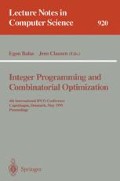Abstract
It is well-known that if augmenting paths are used to solve a max flow problem then two problems can arise: 1) the number of augmenting paths needed can depend on the size of the capacities; and 2) if the capacities are irrational then the algorithm need not even converge to an optimal solution. Edmonds and Karp [4] and Dinic [3] were the first to show that these problems can be overcome using minimum length augmenting paths. In this paper we examine to what extent augmenting paths and the results of Edmonds and Karp can be generalized. In particular, we consider these ideas for the following generalized max flow problem (first studied by Fulkerson [7]): maxx 1:Ax=0,0≤x≤c.
Preview
Unable to display preview. Download preview PDF.
References
M.S. Bazaraa, J.J. Jarvis, H.D. Sherali. Linear Programming and Network Flows. John Wiley & Sons, New York, 1990.
W.H. Cunningham. Optimal attack and reinforcement of a network. J. Assoc. Comput. Mach. 32 (1985) 549–561
E.A. Dinic. Algorithm for a solution of a problem of maximum flow in a network with power estimation. Soviet Math. Dokl. 2 (1970) 1277–1280.
J. Edmonds and R. M. Karp. Theoretical improvements in algorithmic efficiency for network flow problems. J. of ACM 19 (1972) 248–264.
P. Elias, A. Feinstein, and C.E. Shannon. Note on maximum flow through a network. IRE Transactions on Information Theory IT-2 (1956) 117–119.
L.R. Ford and D.R. Fulkerson. Maximal flow through a network. Canadian J. of Math., 8 (1956) 399–404.
D.R. Fulkerson. Networks, frames, blocking systems, in: Mathematics of the Decision Sciences, Part 1 (G.B. Dantzig and A.F. Veinott, JR., eds.), Lectures in Applied Mathematics Vol. 11, American Mathematical Society, Providence, R.I. (1968) 303–334.
D.R Fulkerson and G.B. Dantzig. Computation of maximum flow in networks. Naval Reasearch Logistics Quarterly 2 (1955) 277–283.
G. Gallo, M.D. Grigoriadis, R. Tarjan. A fast parametric maximum flow algorithm and applications. SIAM J. Computing, Vol. 18, No. 1 (1989) 30–55.
A.V. Goldberg and R.E. Tarjan. A new approach to the maximum flow problem. J. Assoc. Comput. Mach. 35 (1988).
D. Gusfield. On scheduling transmissions in a network. Tech. Report YALEU DCS TR 481, Department of Computer Science, Yale University, New Haven, CT, 1986.
A. Itai and M. Rodeh. Scheduling transmissions in a network. J. of Algorithms 6 (1985) 409–429.
S.T. McCormick and T.R. Ervolina. Computing maximum mean cuts. UBC Faculty of Commerce Working Paper 90-MCS-011, 1990.
N. Megiddo. Applying parallel computation algorithms in the design of serial algorithms. J.Assoc.Comput.Mach., 30 (1983) 852–865.
C.H. Norton, S.A. Plotkin, and Eva Tardos. Using separation algorithms in fixed dimension. Journal of Algorithms 13 (1992) 79–98.16.
T. Radzik. Parametric flows, weighted means of cuts, and fractional combinatorial optimization. Working paper, School of Operations Research, Cornell University.
A. Schrijver. Theory of Linear and Integer Programming. John Wiley & Sons, New York, 1986.
D.D. Sleator and E.T. Tarjan. A data structure for dynamic trees. 13th ACM Symops. Theory of Computing. Milwaukee, Wisconsin (1981) 114–122.
V. Srinivasin and G.L. Thompson. An operator theory of parametric programming for the transportation problem. Naval Research Logistics Quarterly 19 (1972) 205–252.
E. Tardos. A strongly polynomial algorithm to solve combinatorial linear programs. Operations Research 34 (1986) 250–256.
Author information
Authors and Affiliations
Editor information
Rights and permissions
Copyright information
© 1995 Springer-Verlag Berlin Heidelberg
About this paper
Cite this paper
Hartvigsen, D. (1995). Generalized max flows and augmenting paths. In: Balas, E., Clausen, J. (eds) Integer Programming and Combinatorial Optimization. IPCO 1995. Lecture Notes in Computer Science, vol 920. Springer, Berlin, Heidelberg. https://doi.org/10.1007/3-540-59408-6_51
Download citation
DOI: https://doi.org/10.1007/3-540-59408-6_51
Published:
Publisher Name: Springer, Berlin, Heidelberg
Print ISBN: 978-3-540-59408-6
Online ISBN: 978-3-540-49245-0
eBook Packages: Springer Book Archive

